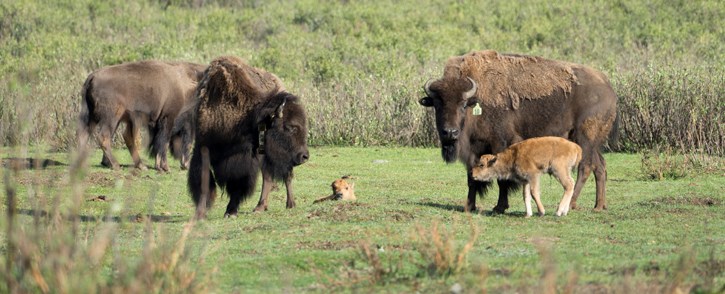BANFF – Banff’s bison herd has grown to between 85 and 90 animals after 16 bison calves were born in the spring.
Parks Canada officials say the herd is doing well, but will update in more detail on the progress later this year.
“Overall, the bison are doing well in the 1,200 square kilometre re-introduction zone,” said Kat Trivers, strategic communications advisor for Parks Canada, in a statement.
Trivers said what has been learned from the five-year pilot bison reintroduction plan will inform future decisions regarding the feasibility of managing a wild bison herd in Canada’s first national over the long-term.
She said Parks Canada is currently preparing a summary report on the pilot project.
“This summary report is expected to be released in the winter of 2022,” she said.
Bison, considered a keystone species that help hold an ecosystem together, were absent from Banff National Park for about 160 years before being brought back as part of a $6.4 million reintroduction project.
Parks Canada translocated 16 plains bison – 10 young females and six young males – from a disease-free herd in Elk Island National Park east of Edmonton to a 16-hectare soft-release fenced pasture in the Panther River Valley on Feb. 1, 2017.
For the first 16 months, bison were held in the fenced area in an attempt to anchor them to their new home before their release into the greater 1,200-square-kilometre reintroduction zone in the remote eastern slopes of Banff in summer 2018.
For the most part, the bison herd stays within the large reintroduction zone, which is fenced off in strategic locations to keep the animals from heading out onto Alberta provincial lands. However, a few male bison have wandered onto provincial lands.
Bison herds once numbered as many as 30 million across North America, but almost went extinct within a single human lifetime. Although many factors led to their near-disappearance, over-hunting was the main cause that left fewer than 1,000 bison.
In Banff National Park area, bison didn’t roam in the vast herds that were common on the plains, but even in low numbers they helped shape ecosystems as the historically dominant grazers.
They alter landscapes in ways that benefit many other plants and animals. For example, bison fur provides insulation for bird nests, bison grazing creates habitat for elk, and they provide a rich source of nutrients for scavengers, bears, and wolves.




